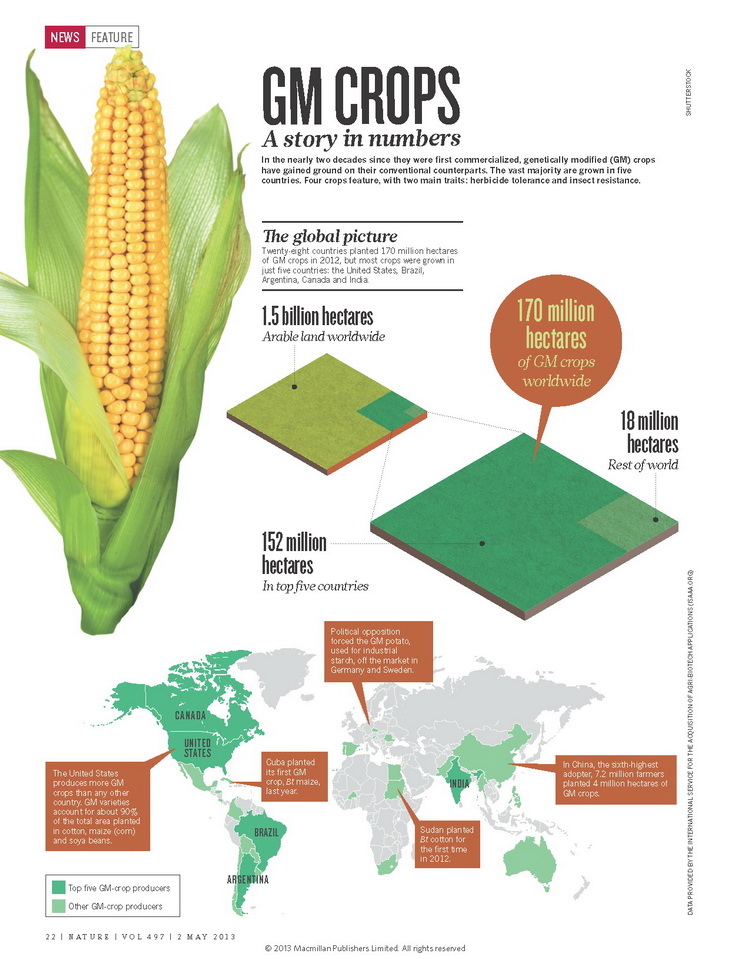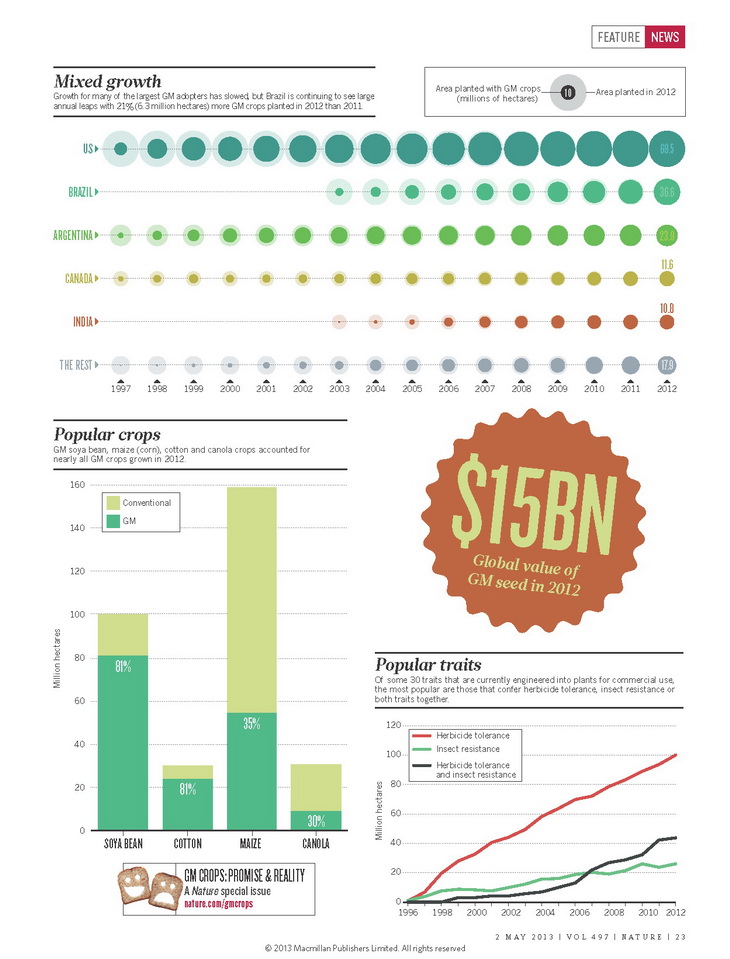|
|
 |
Nature's GM Crops: A story in numbersThe international weekly journal of science Nature featured genetically modified (GM) crops in their May 2, 2013 special issue. Titled GM Crops: Promise and Reality, the special issue highlighted various aspects of GM crops with articles on global biotech crops status (GM Crops: A story in numbers) issues on weeds (Case studies: A hard look at GM crops), upcoming biotech products (Transgenic crops: A new breed), commentaries on biotech crops in developing countries, as well as an article on membrane transporters for food sustainability. Nature’s special issue can be viewed at http://www.nature.com/news/specials/gmcrops/index.html. The slide show GM Crops: A story in numbers published by Nature is reproduced in its entirety, with permission from Nature. Clive James : The go-to source for biotechnology crop dataScientific American WorldView, an online publication on Global Biotechnology Perspective published on April 24, 2013 featured three prominent agbiotech experts who have been actively involved in addressing global hunger crisis through biotech, in their own unique ways. Authored by Elizabeth Waltz, the three experts named were Dr. Rofina Yasmin Othman, Dr. Adrian Dubock and ISAAA’s Dr. Clive James. Reproduced below is Dr. Clive James’ profile as it appears in http://www.saworldview.com/wv/profiles/. Clive JamesThe go-to source for biotechnology crop data There’s only one place to find comprehensive global data on biotech crops, and it’s not the United Nations’ Food and Agriculture Organization or the World Bank or any national agency. It’s a tiny not-for-profit called the International Service for the Acquisition of Agri-Biotech Applications, or ISAAA. This group serves as the go-to source for everyone from government officials to journalists. Behind the data is one very connected scientist: Clive James. A plant pathologist with a more than 40-year career in global agriculture and development, James believes that biotechnology is a viable part of the solution to food insecurity in poor countries, and that the best way to encourage the adoption of genetically modified (GM) crops in those areas is by sharing knowledge about how the technology is being used globally. The task his harder than you’d think. James has spent decades building an extensive network of international fact finders who supply him with numbers on an annual basis; usually more than one estimate for any one data point. It’s a tough task when each country comes up with its own statistics based on its own definitions and, often, its own biases. ISAAA’s signature data set is a tally of the global land area planted with biotech crops, which has been growing steadily since the organization began tracking it in 1996. According to ISAAA’s graph, a record 395 million acres were planted with biotech crops in 2011 and, most important to James, developing countries for the first time accounted for half of that. “I call it the Clive curve,” says Dafang Huang, former director of biotechnology at the Chinese Academy of Agricultural Sciences in Beijing. Huang says he has used the graph, along with other data, to encourage China’s former and current prime ministers to embrace the technology. “We make policy to develop biotechnology based on that curve,” Huang says. That’s just how James hoped his data would make its mark. “A farmer in a developing country sees that a farmer in Burkina Faso is using biotechnology and thinks: ‘Why can’t I do that?’” says James. “We share with them what has already been achieved and let them decide what to do.” It’s not the most direct way to get GM crops into the hands of poor farmers. But as James sees it, knowledge is the foundation for the acceptance of the technology. Without it, fear and misunderstanding stirred up by naysayers would guide policy, leaving no pathway for crop development. Power of Being a People Person He moved to Mexico in 1981 to work for the International Maize and Wheat Improvement Center (CIMMYT) where he served as deputy director general for research. There he developed a close working relationship with Norman Borlaug, a Nobel Peace Prize laureate who is known as the “father of the green revolution.” Borlaug valued strongly the role of technology in achieving food security, and James admired him for that. “It’s not often that you have the chance to get to know a Nobel laureate and travel around the world with him, getting his wisdom,” says James. James adopted much of Borlaug’s way of thinking. “Norman didn’t fear people and some of that rubbed off on Clive,” says Richard Flavell, chief scientific adviser at Ceres in Thousand Oaks, California, and former secretary to ISAAA. “Norman was willing to say to any government leader what he believed,” Flavell says. “Clive has that directness.” James’s first major foray into biotechnology was helping create a molecular genetics lab at CIMMYT in 1986. The lab established CIMMYT’s capacity to collaborate in biotech’s early years. It also gave James an opportunity to build a network of international contacts in crop biotechnology. “Clive thought nothing of having breakfast in one country, lunch in another country and dinner in another,” says Ronald Phillips, a genomics professor emeritus at the University of Minnesota who accompanied James on several networking trips to Europe. But James wanted to do more to bring biotech crops to developing countries. “Clive, from his experience with CIMMYT, felt that developing countries were unlikely to get into the technology with the urgency that we all thought was important,” says Flavell. In 1990 James retired from CIMMYT to found ISAAA. The Biotech Broker He was a natural. James went on to broker 10 public-private deals in ISAAA’s first decade. “There wasn’t another organization doing that at the time, and that was its value,” says Flavell. But by the late 1990s, public opinion of biotech had changed. “It became harder to raise money from foundations and part of the reason it was hard was because of the unease stirred up by the Greenpeaces of the world,” says Flavell. Also by then, other agencies began serving as liaisons in agricultural biotech, and ISAAA’s role ceased to be unique, he says. Undeterred, James began to see knowledge dissemination as the crucial piece to his mission. ISAAA’s primary communication, its annual report, now reaches millions in 70 countries in more than 50 languages. The nearly 300-page document breaks down the distribution of crops by country, crop and trait, and James seems to have much of it memorized. Ask him a question about the regulatory barriers blocking the adoption of biotech crops, and he’ll invariably answer with a number that suggests that things are looking up. “Fifty percent of growth in biotech crop production is in developing countries,” he might say. Like his mentor Borlaug, James’s legacy, in part, may end up being his optimism.
|
Do not hesitate to tell other colleagues/contacts about this mail list. If they wish to join, they may do so at http://www.isaaa.org/subscribe If you will be changing your e-mail address soon, please update your subscription preferences to continue receiving the Crop Biotech Update. Please visit Crop Biotech Update web pages (http://www.isaaa.org/kc) to view previous issues of this newsletter and see other available resources for download. |

